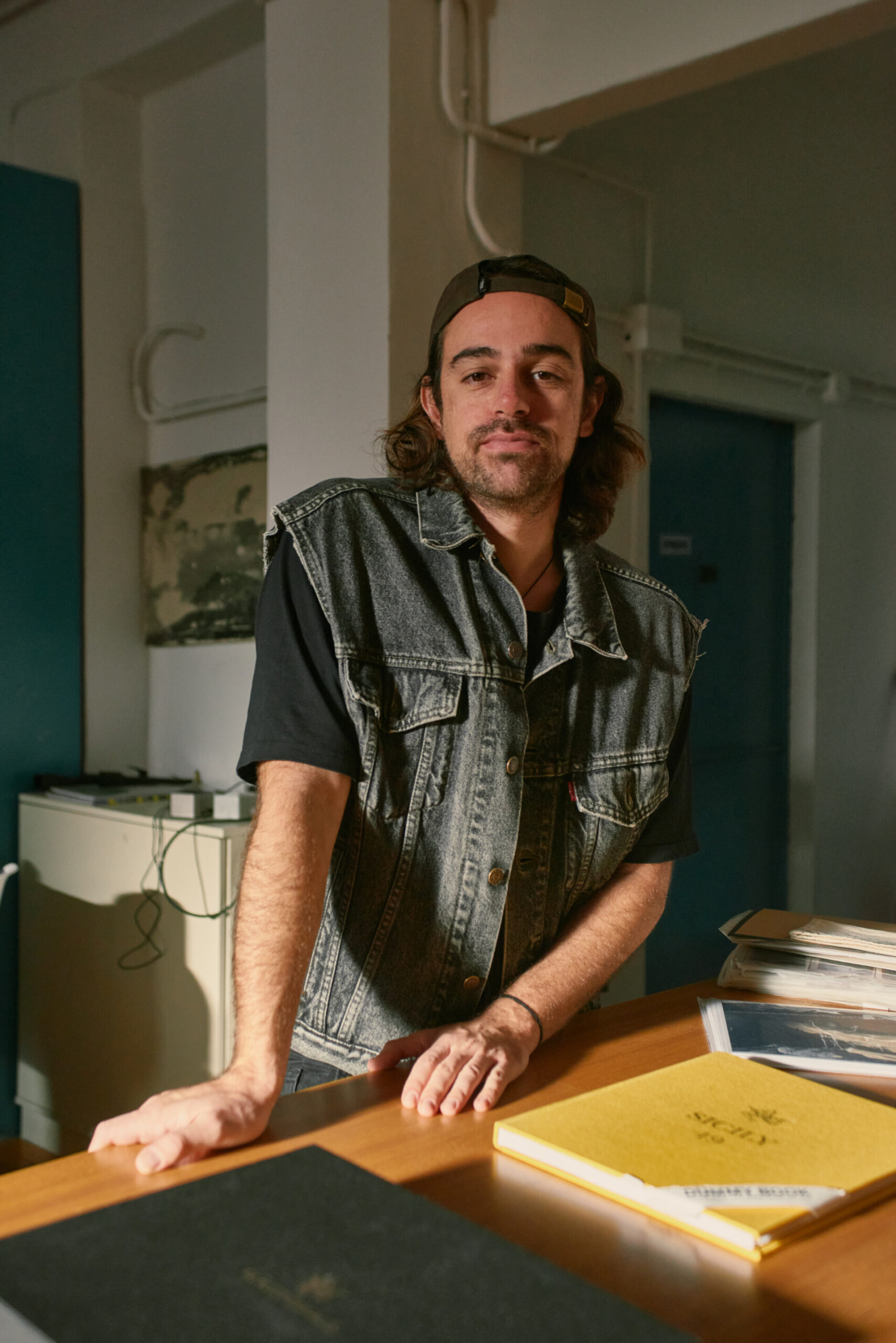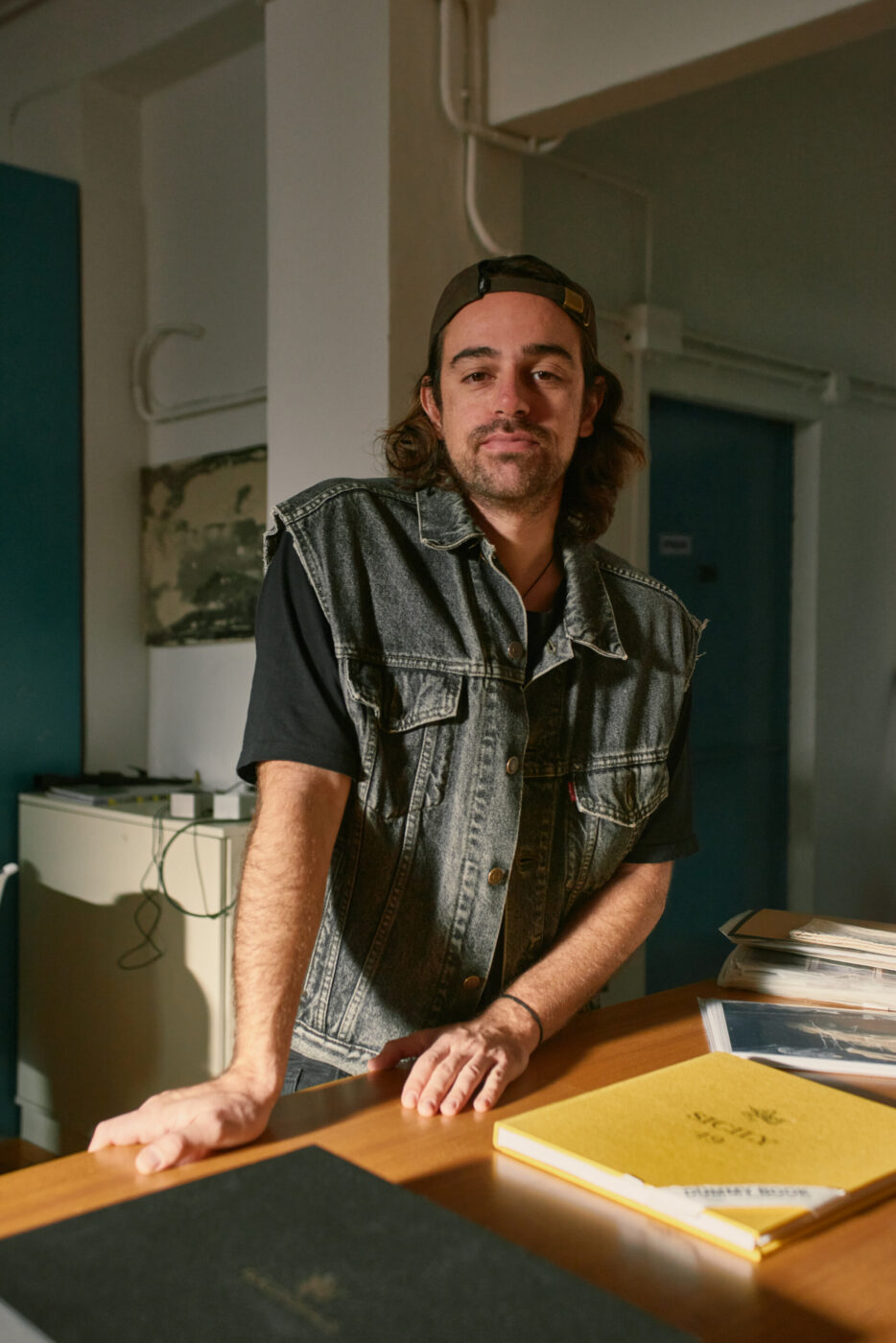Tell us a bit more about your background and your current work:
As I write in my artist statement, I am inspired by the Mediterranean landscapes of my upbringing and, behind the reasons for which, my work investigates space and identity, often through youth; there is perhaps a connection to my childhood and coming of age. With my work, I am often finding myself into something that mirrors moments and experiences of my early life.
I grew up in a small city that was largely urbanized and developed, yet preserved certain areas where wild nature would still grow untouched. It was in these spaces in between, where nature would strive freely, that we, as kids, used to play and discover the world around our houses. Hiding in bushes and plants, climbing trees, leaping over fences, breaking into private gardens, climbing up hills overlooking the city, or rolling down ravines. We were constantly seeking a privileged point of view or a secluded spot, hidden from everyone’s eyes where we could do our secret things away from the overlooking eyes of our parents.
The space I grew up in is alive in my spirit and memory, strongly reverberating in my identity, and kicks in every time I have a doubtful or difficult moment. I think all of my experiences and memories from my childhood have somewhat played a part in my latter choice of path, passion, and career. My father, a hobbyist photographer, instilled something in me during my childhood. He would set up a small slide projector in my bedroom and project his photos from his travels around Italy and his years as a student in Rome (in the 70s).
I have vivid memories of all my childhood troubles and mischief; sometimes I feel I was somehow more of an active spectator.
Why did you choose to stay in Italy?
I have sort of followed the flow of things. I have spent the past 10 years of my life in the UK. After Covid and Brexit, things have changed in Britain. It’s been harder to land work and with the market shrinking, it became clear that clients and agencies were more oriented in choosing British talents–something that I respect as it preserves and grows local talents. In Italy we tend to have the opposite approach, which I don’t really see as healthy. It also happened that, in 2021, Controluce approached me and proposed to represent me in Italy. Therefore, having an agency and more work coming from Italy, I decided to relocate and set up a base in Milan–yet I’m constantly traveling so Milan is pretty much the place where I come back and spend the odd 10 days in between jobs that take me elsewhere. I am happy to have my base here now, although I miss what cities like London and Paris can offer, in terms of openness and cultural exchange, compared to Milan. But staying in Milan gives me a good balance; I have a steady flow of commercial work, yet I can very quickly go to London and Paris for work. The more financial stability I have acquired, compared to my recent years in London especially, has allowed me to have more time off and self-fund my personal projects, which often takes me to the south of Italy and the Mediterranean region in general.
What do you see for the future of the photography industry in Italy?
I feel more like talking about the present, as the future has become very much a distant and abstract concept, for our generation especially I’d say. Generally I think the photography industry in Italy is still far from being called an industry. It’s growing though. I think it’s also important to distinguish between photography in the commercial realm and authorial work. For what concerns the commercial aspect of photography, I do hope that Italian agencies will take the chance to grow their own internal talents and market and stop selling-off labor and artists to foreign brands willing to work for cheaper in Italy. Having dealt with clients and markets from the UK and Northern Europe, it’s frustrating to find out that brands coming to Italy tend to dedicate a third or fourth of the budgets they invest in their same campaigns abroad. I have often realized campaigns that were part of a wider-European commercial plan and found out that the total budget of the same campaign in Italy was much lower–with all the talents, including fellow photographers, in Paris or London paid three times as much as what was offered in Italy. Until our agencies won’t turn down these jobs, the market cannot grow, and therefore artists will not be put in the conditions of working and realizing big ideas. For what concerns authorial work, it is encouraging to see that so many festivals, platforms, and curatorial organizations in the photographic field are thriving in Italy.
Yet it’s still a long journey. The biggest discrepancy that I feel between Italy and the UK is that photography in England is considered an established and noble form of documenting culture, widely recognised institutionally from the top tier governmental organs to the smallest realities in villages and councils. It may be argued that this is connected to the colonialist past of this country, but it remains a diffused and ingrained approach legitimizing photography as an instrument to investigate and preserve culture. In Italy, starting from the bottom, the role of photographer is something that people connect to a hobby, or a wedding photographer when connected to a profession. With this in mind, we look up at our government, and there is no photography in the books when it comes to cultural plans. Generally speaking in Italy, “art” is something that is directly connected to cinema, painting, sculpture, and contemporary art. Either photography or performative arts (and many others) are still somehow considered minor realities, or of minor importance. Not many art galleries are entirely focussed on photography, and there are even fewer if we seek those that are trying to market a certain engaged form of photography. Not many artists nowadays can live off of gallery sales or private collectors.
Authorial photographers are often relying on grants and awards, with a naturally higher competition; very few commissions are coming from institutional platforms and, when they do, the bureaucracy and payment processes take months, or years, literally. Sadly, if we have to talk about the current state of the art, we can’t separate it from the money involved. Fundings are fundamental for an artist, equally to make a living, pay for instruments, spaces to work, travels and logistics and a lot of other factors making the process of work as an artist sustainable. It may sound like a rant, but generally I think photography in Italy is in a growing curve, slowly but growing. But many things have to be changed in order to achieve organic and positive growth.
What are the greatest hurdles you face?
With my previous answer I may have already pointed out some relevant difficulties. Again here I would distinguish between my authorial and commercial work. In both cases, I’m really bad at editing my work. It takes me days, weeks, months, and sometimes years when it comes to personal work, to select and choose the direction I’m following. In my personal work I really need to let a project sink in before the compass aligns and I’m finally on the route I chose to follow. I often start photographing people and places following my impulse. And later I figure out
why. In the case of my most recent work, “The Darker the Night, the Brightest the Stars” * –which I have exhibited in the past year in Braga (Eimagem), Monopoli (PhEst), and Festival Circulation(s) in Paris–it took me about five years of journey to understand that I was delving into this topic as a way to reconcile and reenact my youth.
For this I thank curator Carine Dolek, who became a fundamental figure in these latest steps and mentored my reflective process on this work. Here is another difficulty: that of writing/thinking about my work. It’s a long process. Applying for grants is the best workout you can do for understanding your work. Along with a lot of conversations and confrontations. For these I tend to refer to a few close friends like fellow photographer Daniel Castro Garcia and my research partner Naomi Accardi who are both constantly present in my thinking/writing processes when I’m either applying for grants or presenting my work in some shape or form.
Speaking of sharing and talking about my work as a way to understand my practice, another hurdle I face, being a solo artist, is the lack of confrontation. Something I was pushed to do in the years of my Master at Plymouth University and that, with moving out of the university and onto freelancing, somehow faded out. Lonely thinking often leads you to tunnel vision, and therefore it is important, and very difficult, to form a group of close and reliable persons who have eyes and ears for you–so fundamental for our practice, I couldn’t stress this enough.
* “The Darker the Night, the Brighter the Stars”, is a long term project exploring youth culture in the Torretta district in Napoli. […] Over time the emphasis of this project has shifted from focussing on the ritual [of Cippo di Sant’Antonio] to accompanying the participants into adulthood; following the evolution of their relationships, and the development of their individual and collective identity. In turn, this research explores important social issues intersectional to this demographic. High rates of teenage pregnancy, crime and unemployment are setting the political undertone of this underdeveloped working class environment and this work seeks to confront the traditional misrepresentations of the community. (Excerpt from “The Darker the Night, the Brighter the Stars” project brief.)





